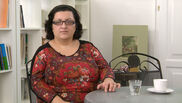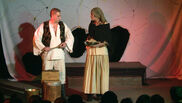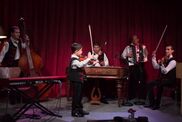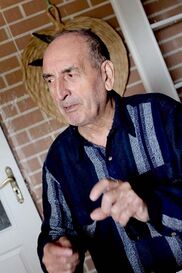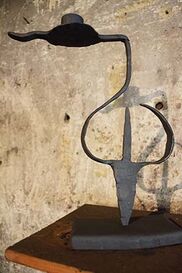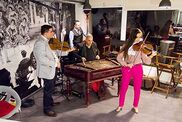Lýdia Gabčová
created: 27. 08. 2019 10:40 modified: 27. 11. 2020 02:00
Mgr. Lydia Gabcova graduated from the University of Konstantiv the Philospher in Nitra, specialization in the social work. After graduation she continued her education during her internships with Council of Europe and European Commission. Specialization in the Romani language was the field she studied at the University of Manchester in Great Britain. Currently, she works as the project manager of many projects ofocused on integration of Roma. The interview is about her personal and professional life as well as about the social processes which happened after 1989.
category: speaking
tags: retrospective biographical monologue guided Slovak Lýdia Gabčová general audience internal
The Devilish Violin Orchestra
created: 26. 08. 2019 16:32 modified: 27. 11. 2020 02:00
Jan Berky Mrenica and the Devilish Violin Orchestra, in cooperation with the Romani Association in Poland presented the concert named Music Without Borders. There played Jan Berky-Mrenica, The Devilish Violin Orchestra, Jozef Mernstein Jochymczyk from Poland and the students of the Private Middle School in Kezmarok. The concert was recorded on 2nd of December, 2013 in Kezmarok.
category: music
tags: vocal-instrumental modern mix orchestra original Slovak Diabolské husle general audience internal
Romano hangos – kompletný archív vydaní v roku 2007
created: 21. 08. 2019 15:47 modified: 24. 03. 2020 10:38
Časopis Romano hangos (Rómsky hlas) je dvojtýždenník vydávaný Spoločenstvom Rómov na Morave. Noviny vychádzajú v tlačenej a elektronickej verzii. Zakladateľom novín je významná česká osobnosť Ing. Karel Holomek (1937). V rokoch 1990-1992 bol poslancom Českej národnej rady. Noviny vychádzajú v Českej republike od roku 2000. Obsah novín je v češtine a rómčine.
zdroj: http://www.srnm.cz/
Kompletný archív vydaní novín v roku 2007, číslo 1 až 24, ročník 9.
č. 2-3, č. 4, č. 5, č. 6, č.7, č.8, č.9, č.10, č.11, č.12, č.13-14, č.15, č.16, č.17, č.18, č.19, č.20, č.21, č.22-23, č.24
category: literature
Romathan - A Golden Horseshoe
created: 21. 08. 2019 15:41 modified: 27. 11. 2020 02:00
The theater performance for children and youth, performed on 6th of December, 2013 in the Romathan Theater. The fairy-tale is built upon the dramatic situations which occure when the magical world of the magical beings meet the real world of people. The main message of the tale is to teach the kids that love and friendship are a person's biggest fortune.
category: drama
tags: theater comedy singspiel stage original Slovak Romathan children and youth internal
Zaneta Stipakova - Speaking
created: 19. 08. 2019 14:32 modified: 27. 11. 2020 02:00
Zaneta Stipakova graduated from the Middle School of Arts in Kosice where she specialized in music and dramatic arts. She finished higher middle education there. She worked as a voice pedagogue in The Private Conservatoir in Prague and later as a teacher's assistant in elementary school in Kosice.
Currently, she is a member of the Romathan Theater. She is the actress, singer, director and also she writes her own dramas.
The interview is about her personal and professional life as well as about the Romani culture.
category: speaking
tags: retrospective biographical monologue guided Slovak Žaneta Štipáková general audience internal
The Folk Band of Julius Bandy
created: 16. 08. 2019 15:11 modified: 27. 11. 2020 01:47
A set of photos of the family folk band from Presov, in which music is passed from generation to generation. The band members are the father, Julius Bandy and his three sons – Kristian, Julius and Samuel. They play cimbalom, double bass, violin and viola. They play both classical and dance music genres. Their repertoire include both Slovak and Romani folk music as well as music of other national minorities – Jewish, Ruthenian, Hungarian, Russian. They also play music from film.
The father, Julius Bandy, comes from musician family. He was born in Velky Saris. He graduated from the Elementary School for Music of Mikulas Moyzes as a cimbalom player. He also plays saxophone, double bass and harmonica. In the years 1982-1983 he played in the children folk ensemble Dubravienka in Presov. In the years 1985-1986 he was a part of the children folk ensemble Sarisancek in Presov. As 15 years old he started playing in the Theater of Alexander Duchnovic in Presov. His military service brought him to the Army Esemble of Art Janosik in Zvolen (1993-1994). He played cimbalom in several other bands and esembles – the Folk Band Presovcan, the Folk Ensemble Sabinovcan, the Folk Band Czardasz from Presov, the Folk Band of Jan Budyi from Humenne.
Kristian Bandy studied studied violin at the Elementary School of Art of Mikulas Moyzes in Presov. He continued his studies at Private Conservatory of Dezider Kardos in Presov (1-3 years), later moved to the Private Conservatory of Music and Drama in Kosice (4-6 years). He will study violin further on the Catholic University in Ruzomberok, the local branch in Spisske Podhradie. He is a guest player in the orchestra of the Romathan Theater, he leads the music part of the ensemble Fialecka at the Elementary School Srobarova in Presov. In the family band he plays viola.
Julius Bandy studied cimbalom at the Elementary School of Art of Mikulas Moyzes in Presov. He continued his studies at the Private Conservatory of Music and Drama in Kosice (1-4 years), which he graduated from at the end of the school year 2018-2019. In the family band he plays the double bass.
Samuel Bandy is the lead violinist of the family band. He studies violin at the Elementary School of Art of Mikulas Moyzes in Presov. For his excellen musical performance as a violin player he received several awards from competitions in Slovakia.
The family band was founded in 2013.
The sons Kristian and Julius graduated from the Private School of Music and Drama Arts in Kosice. The youngest one, Samuel, attends one of the elementary schools in Presov.
category: music
tags: vocal-instrumental classic modern mix quartet original borrowed general audience internal
Viliam Šarközy st.
created: 16. 08. 2019 12:22 modified: 27. 11. 2020 01:47
Viliam Šarközy (1939) is currently the oldest artistic smith in Dunajska Luzna. His smith products were many years sold by ULUV – the network of shops offering the folk art products. He is the author of many large sculptures; all of them made with great deal of artistic vision and smithery skill.
Formerly, Dunajska Luzna was called the Iron Village. Smithery as a craft has more than 300 years long tradition there; until today being the place with the highest number of forges in Slovakia.
The set of photos documenting the memories speech about the craft of smithery.
category: speaking
tags: retrospective biographical monologue guided Slovak Vilam Šarközy general audience internal
Ivan Akimov
created: 16. 08. 2019 12:10 modified: 27. 11. 2020 01:47
Ivan Akimov, the musician with a Russian roots, growing up in France, living in Kežmarok, Slovak republic, professional leader of artistic ensemble for children Kesaj Tchave. For his long lasting work in an artistic field, he was awarded by the Ambassador of France in Slovakia and obtained the state honours of the Order of the National Knight.
The set of photos documents the performance of the ensemble Kesaj Tchave in the event Live Book organized by the State Scientific Library in Presov.
category: dance
tags: folklore authentic male female ensemble original choreography Ivan Akimov general audience internal
Candelabra
created: 28. 06. 2019 14:47 modified: 27. 11. 2020 01:47
Igor Radič was born in 1960 in Klenovec. He was interested in smithing since his childhood. After finishing the vocational school, he started to work as a smith in a collective farm in Klenovec. He was taught by the old smith masters. Since 1995, he´s engaged in business. He´s an authorised representative of Roma Smithcraft Civic Association, which holds Smith Workshops. He´s doing both industrial smithery and smithcraft. At work in smithy his son, Igor Radič Jr. (1984), is helping. The photograph catches a candlestick, made according to his own design idea.
category: Crafts
tags: active traditional utilitary metal smithery Igor Radič general audience internal
Barbora Botošová
created: 27. 06. 2019 15:23 modified: 27. 11. 2020 01:47
The file contains sixteen colour photographs of the first violinist Barbora Botošová with her accompanying band, created during the concert in Bratislava, which took place in the club Estévéčka, Sekurisova 16 street, on 7th February 2014.
category: music
tags: instrumental modern mix orchestra borrowed Barbora Botošová general audience internal




